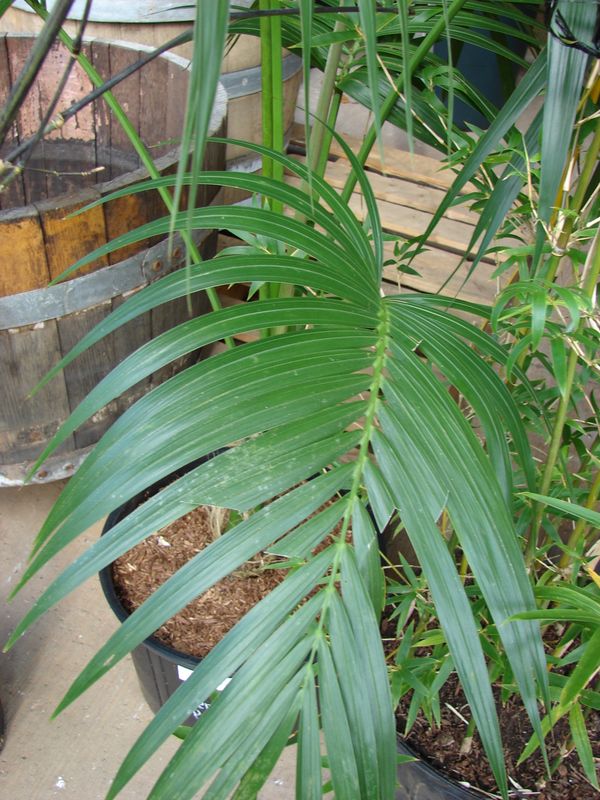Kentia Palm Care Guide
How to grow and care for Kentia Palm (Howea forsteriana)
The Howea forsteriana, commonly known as the Kentia Palm, is a popular choice for indoor plant enthusiasts due to its graceful, arching fronds and ability to thrive in low-light environments. Native to Lord Howe Island in Australia, this palm brings a touch of the tropics to any home or office interior. Valued for its resilience and ease of care, the Kentia Palm makes an excellent choice for beginners and experienced plant caretakers alike.

Disclosure: This content includes affiliate links, which means we may earn a commission if you click on a link and make a purchase. As an Amazon Associate, we earn from qualifying purchases. This comes at no extra cost to you and helps offset the cost of running Leafwise. Please read our disclaimer for more info.
Table of Contents
Care
Light
Kentia Palms thrive in environments with bright, indirect light but can also tolerate low-light conditions, making them ideal for indoor spaces. Avoid direct sunlight, which can scorch the fronds. A location with filtered light or semi-shade is best.
Temperature
These palms prefer temperatures between 65°F and 75°F (18°C–24°C). While they can tolerate brief dips as low as 25°F (-4°C), prolonged cold exposure should be avoided. Keep the plant away from cold drafts or sudden temperature fluctuations.
Watering
Water when the top inch of soil feels dry. Let the soil dry slightly between waterings to prevent root rot. During fall and winter, reduce the frequency of watering as the plant's growth slows. Always use pots with proper drainage to avoid soggy conditions.
Humidity
Kentia Palms prefer moderate humidity but adapt well to average indoor environments. If the air is dry, increase humidity by misting the leaves, using a pebble tray, or running a humidifier nearby. Avoid overly dry or excessively humid environments to prevent stress.
Soil
Kentia Palms prefer a well-draining, loose soil mix that retains some moisture without becoming soggy. A loamy or sandy potting mix is ideal. You can improve drainage by incorporating perlite or coarse sand. The preferred soil pH is slightly acidic to neutral (6.0 to 7.0). Always use pots with drainage holes to help prevent root rot.
Maintenance
Cleaning
Dust buildup on fronds can hinder photosynthesis. Gently wipe leaves with a damp cloth to keep them clean and healthy. Regular cleaning also helps deter pests.
Fertilizing
Feed monthly during the growing season (spring and summer) using a balanced, water-soluble fertilizer diluted to half strength. Avoid fertilizing in fall and winter. To prevent salt buildup and potential leaf tip burn, flush the soil occasionally with clean water.
Repotting
Repot your Kentia Palm every 2–3 years or when it becomes root-bound. Signs that repotting may be necessary include roots growing out of the drainage holes, slowed growth, or the plant becoming top-heavy and unstable. Choose a pot one size larger with excellent drainage and use a loamy or sandy potting mix. Handle roots carefully, as they are sensitive and prone to damage.
Propagation
Propagation of Kentia Palms is difficult for home growers. These plants grow slowly and are typically propagated from seed rather than division. Seed germination requires warm, humid conditions and can take months. Due to these challenges, most propagation is handled commercially.
Common Issues
Pests
- Symptoms: Webbing, sticky residue, discolored spots, or visible insects on fronds.
- Cause: Common indoor pests such as spider mites, scale, and mealybugs, often due to dry air.
- Solution: Wipe affected leaves with soapy water or treat with neem oil or insecticidal soap. For severe infestations, consider introducing natural predators like ladybugs.
Diseases
Root Rot
- Symptoms: Yellowing fronds, wilting, and a sour smell from the soil.
- Cause: Overwatering or poor drainage.
- Solution: Ensure the pot has proper drainage holes and allow the soil to dry between waterings. Repot if needed, trimming away any mushy or blackened roots.
Yellowing Leaves
- Symptoms: Leaves turning yellow or brown, often starting at the tips.
- Cause: Over- or underwatering, nutrient deficiency, or sudden environmental changes.
- Solution: Adjust watering habits to maintain consistent moisture without overwatering. Ensure adequate lighting, feed regularly during the growing season, and keep the plant away from cold drafts or heat vents.
With proper care and attention to its needs, the Kentia Palm can thrive for years as a graceful and resilient houseplant.
